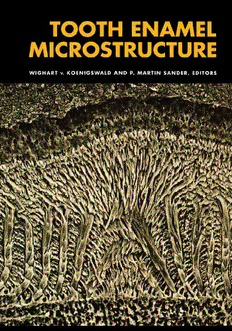
Tooth Enamel Microstructure: Proceedings of the enamel microstructure workshop, University of Bonn, Andernach, Rhine, 24-28 July 1994 PDF
Preview Tooth Enamel Microstructure: Proceedings of the enamel microstructure workshop, University of Bonn, Andernach, Rhine, 24-28 July 1994
TOOTHENAMELMICROSTRUCTURE PROCEEDINGSOFTHEENAMELMICROSTRUCTUREWORKSHOP UNIVERSITYOFBONN/ANDERNACH/RHINE/24-28JULY 1994 TOOTH ENAMEL MICROSTRUCTURE Editedby WIGHARTV. KOENIGSWALD &~ MARTINSANDER InstitutfiirPaliiontologie, UniversitiitBonn, Germany A.A.BALKEMA/ ROTTERDAM/BROOKFIELD/ 1997 Authorizationtophotocopy itemsforinternalorpersonal use,ortheinternalorpersonal useofspecific clients, isgranted by A.A.Balkema, Rotterdam, provided that the base fee of US$I.50 per copy,plus US$0.10 per page is paid directly to Copyright Clearance Center, 222 Rosewood Drive, Danvers, MA 01923,USA.ForthoseorganizationsthathavebeengrantedaphotocopylicensebyCCC,aseparate systemofpayment hasbeenarranged.ThefeecodeforusersoftheTransactional ReportingService is: 9054106670/97US$I.50+US$0.10. Published by A.A.Balkema,EO.Box1675,3000BRRotterdam,Netherlands (Fax:+31.10.4135947) A.A.BalkemaPublishers,OldPostRoad,Brookfield,VT05036-9704,USA(Fax:802.276.3837) ISBN9054106670 © 1997A.A.Balkema,Rotterdam PrintedintheNetherlands Toothenamelmicrostructure, W.v.Koenigswald&P.M.Sander(eds)©1997Balkema, Rotterdam Contents Listof contributors VII Introduction 1 W.V. KOENIGSWALD& P.M. SANDER Ontogeny 1 Theontogeny ofmammalianenamel 5 L. MOSS-SALENTDN, M.L. Moss& M.S. YUAN Crystallite level 2 A shortreview ofstudies on chemical and physicalproperties ofenamel crystallites 31 T. SAKAE, K. SUZUKI&Y. KOZAWA Prism level 3 Non-mammaliansynapsidenamel and the originofmammalianenamel prisms: The bottom-upperspective 41 P.M. SANDER 4 The earliestprisms in mammalianand reptilianenamel 63 C.B. WOOD& D.N. STERN 5 Characterizationofenamelmicrostructure terminology and application of the origins ofprismatic structures in systematic analyses 85 W.A. CLEMENS 6 Tubules in Australian marsupials 113 C.F. GILKESON Enameltype level 7 Differentiationsin Hunter-Schregerbands ofcarnivores 123 C. STEFEN v VI Contents Schmelzmusterlevel 8 Briefsurvey ofenamel diversity at the schmelzmusterlevel in Cenozoic placentalmammals 137 W.V. KOENIGSWALD 9 Incisorenamel microstructure and systematics in rodents 163 T. MARTIN 10 Theenamel structureofsome fossil and recentwhales from the Indian subcontinent 177 A. SAHNI& W.V. KOENIGSWALD Dentition level 11 The variabilityofenamel structureat the dentition level 193 W.V. KOENIGSWALD Evolution 12 Evolutionarytrends in the differentiationofmammalianenamel ultrastructure 203 W.V. KOENIGSWALD Biomechanics 13 Mechanical adaptationin enamel 237 J.M. RENSBERGER 14 Schmelzmusterdifferentiation in leading andtrailingedges, a specific biomechanical adaptationin rodents 259 W.V. KOENIGSWALD& P.M. SANDER Terminology 15 Glossaryofterms usedfor enamel microstructures 267 W.V. KOENIGSWALD& P.M. SANDER Toothenamelmicrostructure, W.v.Koenigswa/d&P.M.Sander(eds)@1997Ba/kema, Rotterdam List of contributors Prof. Dr William A. Clemens, Museum of Paleontology, University of California, Berkeley, CA 94720, USA. Coral F. Gilkeson, Philips Scientific & Industrial Electronics, ACN 008 445 743, 34 WaterlooRoad (P.O. Box 119), NorthRide, NSW 2113, Australia. Prof. Dr Wighart v. Koenigswald, Institut fur Palaontologie der Universitat Bonn, Nussallee 8,D-53115, Bonn, Germany. Dr Yukishige Kozawa, Nihon University School of Dentistry at Matsudo, Chiba Ken 271, Japan. Dr Thomas Martin, Institutfur Palaontologie der Freien UniversitatBerlin, Malteser strape74-100, Haus D, D-12249, Berlin, Germany. Melvin L. Moss, DDS, PhD, Department of Anatomy & Cell Biology, Columbia University, 630 West 168thStreet, New York, NY 10032-3702,USA. Letty Moss-Salentijn, DDS, PhD, Department of Anatomy and Cell Biology, ColumbiaUniversity, 630 West 168th Street, New York, NY 10032-3702,USA. Dr John M. Rensberger, Department of Geological Sciences and Burke Museum, University of Washington, Seattle, WA 98105, USA. Prof. Dr Ashok Sahni, Centre of Advanced Studies in Geology, Panjab University, Chandigarh 160014, India. Dr Toshiro Sakae, Nihon University, School of Dentistry at Matsudo, Chiba-Ken 271, Japan. PO Dr P. MartinSander, Institutfur Palaontologieder Universitat Bonn, Nussallee 8, 0-53115, Bonn, Germany. Dr Clara Stefen, Institut fur Palaontologie der Universitat Bonn, Nussallee 8, 0 53115 Bonn, Germany. Dr Doris Stem, ForsythDentalCenter, 140TheFenway, Boston, MA 02115, USA. Dr Kunihiro Suzuki, Nihon University School of Dentistry at Matsudo, Chiba-Ken 271, Japan. Dr Craig B.Wood, Biology Department, Providence College, Providence, RI 02918, USA. Michael Sheng-tien Yuan, DDS, MA, Department of Anatomy and Cell Biology, ColumbiaUniversity, 630 West 168th Street, New York, NY 10032-3702,USA. VII Toothenamelmicrostructure, W.v.Koenigswald&P.M.Sander(eds)©1997Balkema, Rotterdam Introduction WIGHART v. KOENIGSWALD &P. MARTINSANDER InstitutfurPaliiontologieder UniversitiitBonn, Germany Enamel, the shiny material covering the teeth of vertebrates is the hardest tissue the vertebrate body can produce and one ofthe most impressive products of biominerali zation. This hard tissue is closely related to feeding, the first part in the energy intake process so basic to vertebrate life. Enamel has a complex internal microstructure full of phylogenetic and biomechanic information. Research was centered around human enamel which, however, is not representa tive for the structural diversity seen in the mammalian spectrum. In addition, ontoge netic models for enamel formation deduced from human enamel are not sufficient to describe enamel formation in general. For instance, the formation of such a com monly observed structure as uniserial HSB in rodent incisors has to be incorporated in ageneral model ofamelogenesis in prismatic enamel. The history of enamel research is closely linked to the advances in microscope technology. Enamel received renewed interest with each step in the development of modern microscope technology. First observations on a structure within the enamel were already made in the 18th century without the aide ofa transmitted light micro scope by HUNTER (1778) and SCHREGER (1800). Based on histological techniques and much improved light microscopes, a second research tradition was established by TOMES (1850) who focused on the formation ofenamel. This tradition spreading out from Britain culminated in the work of BOYDE(1964 ff) using scanning electron microscopy and tandem scanningreflecting lightmicroscopy. The descriptive approach which includes the investigation of fossil teeth was pushed forward by KORVENKONTIO (1934) examining the great variety ofrodent in cisors. He made the point, that enamel structure contains important characters for phylogenetic studies. In Japan SHOBUSAWA(1952) and KAWAI (1955) made inven tories ofprism cross sections and the thickness ofHunter-Schregerbands. Significant biomechanical aspects became obvious when KOENIGSWALD (1980) studied rodent molars and found a close relationship between the distribution of the enamel types (schmelzmuster) and functional requirements. Scanning electron microscopy encouraged many workers to investigate tooth enamel, not the least triggered by the aesthetic quality of the observed structures. However, the powerful magnification capabilities ofthe SEM draws the attention to very small structures at very high magnifications. This detailed view often obscures the recognition offeatures at a somewhat larger scale which are necessary to under-
